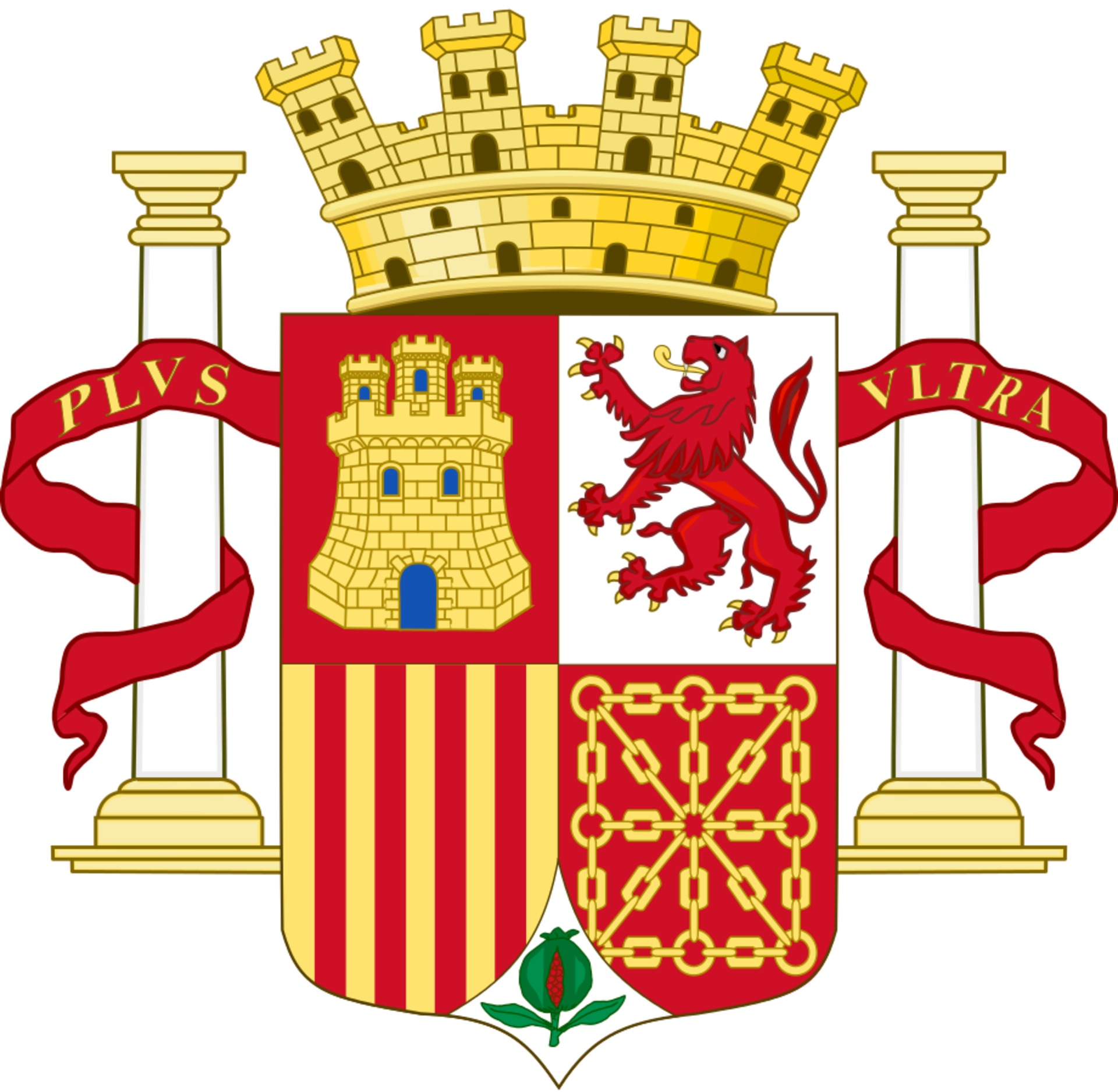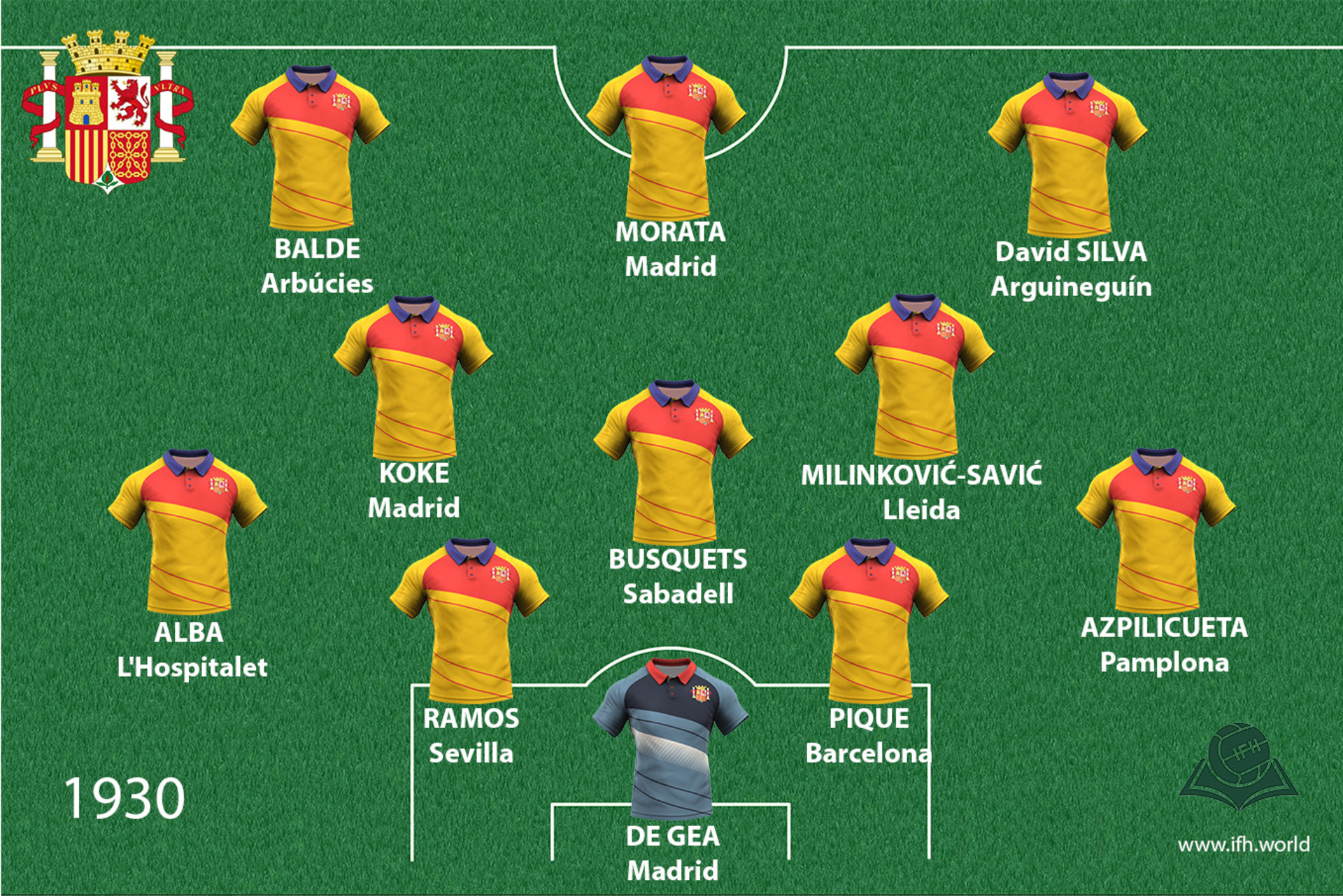Kingdom of Spain
In 1930, Spain was on the brink of civil war. However, King Afonso XIII nevertheless peacefully resigned his post and a republican order was established in the country for the second time in its history (1931-36). It will, however, be short lived, as a bloody civil war will soon break out.

Coat of arms
Shirt
| Position | First name | Last name | Mjesto rođenja | Like | Dislike | |
|---|---|---|---|---|---|---|
| GK | David | DE GEA | Madrid |
24 |
5 |
|
| GK | Iker | CASILLAS | Móstoles |
16 |
0 |
|
| GK | Kepa | ARRIZABALAGA | Ondarroa |
8 |
0 |
|
| DC | Gerard | PIQUE | Barcelona |
19 |
9 |
|
| DC | Raul | ALBIOL | Vilamarxant |
5 |
2 |
|
| DRC | Sergio | RAMOS | Sevilla |
19 |
5 |
|
| DRL | Cesar | AZPILICUETA | Pamplona |
13 |
0 |
|
| DR | Daniel | CARVAJAL | Leganes |
16 |
4 |
|
| DR/MR | Hector | BELLERIN | Barcelona |
11 |
5 |
|
| DL | Jordi | ALBA | L'Hospitalet |
18 |
3 |
|
| DL | Jose Luis | GAYA | Pedreguer |
4 |
0 |
|
| DLC/ML | Marcos | ALONSO | Madrid |
11 |
0 |
|
| DC/DMC | Javi | MARTINEZ | Estella-Lizarra |
10 |
1 |
|
| DMC | Dani | CEBALLOS | Utrera |
4 |
1 |
|
| DMC | Sergio | BUSQUETS | Sabadell |
14 |
2 |
|
| MC | Ander | HERRERA | Bilbao |
8 |
0 |
|
| MC | Andres | INIESTA | Fuentealbilla |
19 |
1 |
|
| MC | Sergej | MILINKOVIĆ-SAVIĆ | Lleida |
16 |
3 |
|
| MC/DR | Sergi | ROBERTO | Reus |
6 |
1 |
|
| MRLC | Jorge Merodio | KOKE | Madrid |
8 |
0 |
|
| MRLC | SAUL | Niguez | Elche |
9 |
0 |
|
| AMC/SS | Cesc | FABREGAS | Arenys de Mar |
11 |
1 |
|
| AMRLC | David | SILVA | Arguineguín |
5 |
0 |
|
| AMRLC | Francisco Román Alarcón Suárez | ISCO | Benalmádena |
12 |
0 |
|
| AMRLC | Marco | ASENSIO | Palma de Mallorca |
21 |
0 |
|
| AMRL/FC | Keita | BALDE | Arbùcies |
6 |
0 |
|
| FRLC | Eliezer Rodríguez Ledesma | PEDRO | Santa Cruz de Tenerife |
1 |
0 |
|
| FRLC | Giovanni | SIMEONE | Madrid |
2 |
1 |
|
| FC | Alvaro | MORATA | Madrid |
11 |
1 |
In Spain, from the restoration of the monarchy (1876) until the end of Prime Minister Prima de Rivera's authoritative regime (1923-30), the system of alternating power of liberals and conservatives prevailed, with a markedly oligarchic, centralist and poorly inclined acceptance of modernization and social change. During this period, there was also a strengthening of regionalisms, or more properly called '' new nationalisms ''. Catalan regionalism did not address the linguistic issue until the late 1880s, and the language itself was competently standardized only in the 20th century. The development of Basque nationalism lagged thirty years behind the Catalan movement, although the ideological diversion of Basque autonomy from the defense or restoration of ancient feudal privileges toward linguistic-racial arguments was abrupt. At the end of the 19th century. The Basque name of the country (Euskadi) was invented and had not existed before. Andalusian regionalism, however, did not have a continuous history until the 1920s. when the notion of Andalusian identity was relentlessly encouraged in his works by publicist Blas Infante. In contrast, Castilian identity is poorly expressed because most Castilians seem to identify with the term Spaniards.
In 1930, the state was on the verge of a civil war. However, King Alfonso XIII abdicated, and then in 1931 came the proclamation of the republic. Second time in state history. The history of the short-lived Second Republic can be divided into 4 distinct phases: the Provisional Government, the Left Republican and Socialist Governments, the Conservative Government of the Radical Republicans and Roman Catholics, which was interrupted by the October 1934 revolution and ended by the electoral victory of the People's Front in February 1936. had too many simultaneous issues (agrarian reform in the south of Spain, regional organization of the country, church-state relations, military reform, social issue) that they could not solve.
The People's Front authority was interrupted by a bloody civil war between Republican (separatists, socialists, anarchists and communists) against conservative forces (old monarchists, phalanges, karlistic ultraists, the Church), and the final outcome was the establishment of an authoritative Franz-led regime (vl.1939- 1975) .The three-year massacre was accompanied by conflicting rhetoric by conflicting parties: Republicans spread propaganda to fight for democracy and freedom against tyranny, repression and fascism, while Franco's supporters portrayed the conflict as a struggle between communist hordes and Christian civilization, or as a struggle. against an atheist revolution that destroyed traditional values. The Franco regime, in addition to its arrest and persecution, had a bloody deal with defeated Republicans. The Catholic Church, which suffered great human losses during the war, endorsed the moves of Franco, "the" new man of God's providence ", holding that the repression was a new Crusade for the benefit of faith. Although the regime had many fascist characteristics: one party, martyrs, symbols, aspirations for cultural purity, corporatism, police state and conservatism, etc., it nevertheless did not accept the elements of racism, nor the use of the party as a tool for mass gathering or aggressive foreign policy, and even Falanga had no parallel structures.
Sources
- Felipe FERNANDEZ-ARMESTO, Narodi Europe, Zagreb, 1997.
- Eric J. HOBSBAWM, Doba ekstrema : kratko dvadeseto stoljeće 1914.-1991, Zagreb, 2009.
- Eric J. HOBSBAWM, Nacije i nacionalizam, Zagreb, 1993.
- Jure Krišto, ''Odjek građanskoga rata u Španjolskoj (1936.-1939.) u Hrvatskoj'', ČSP, br. 3., 1038.
- Robert O. PAXTON, Anatomija fašizma, TIM press, Zagreb, 2012., 154
- Antonio RIVERA, 'Dva stoljeća novije povijesti u Baskiji'', http://www.matica.hr/hr/324/DVA%20STOLJE%C4%86A%20NOVIJE%20POVIJESTI%20U%20BASKIJI/
- Juraj Katalenac: Revolucija i Španjolski građanski rat (1936.-1937.), http://anarhizam.hr/povijest/85-juraj-katalenac-revolucija-i-panjolski-graanski-rat-1936-1937
- ''Primo de Rivera (1923–30) and the Second Republic (1931–36)'' https://www.britannica.com/place/Spain/Primo-de-Rivera-1923-30-and-the-Second-Republic-1931-36#ref587807
- Grb: https://en.wikipedia.org/wiki/List_of_coats_of_arms_of_Spain
